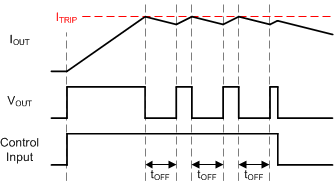SLVSF66A August 2019 – December 2019 DRV8874
PRODUCTION DATA.
- 1 Features
- 2 Applications
- 3 Description
- 4 Revision History
- 5 Pin Configuration and Functions
- 6 Specifications
- 7 Detailed Description
- 8 Application and Implementation
- 9 Power Supply Recommendations
- 10Layout
- 11Device and Documentation Support
- 12Mechanical, Packaging, and Orderable Information
7.3.3.2.1 Fixed Off-Time Current Chopping
In the fixed off-time mode, the H-bridge enters a brake/low-side slow decay state (both low-side MOSFETs ON) for tOFF duration after IOUT exceeds ITRIP. After tOFF the outputs are re-enabled according to the control inputs unless IOUT is still greater than ITRIP. If IOUT is still greater than ITRIP, the H-bridge will enter another period of brake/low-side slow decay for tOFF. If the state of the EN/IN1 or PH/IN2 control pin inputs changes during the tOFF time, the remainder of the tOFF time is ignored, and the outputs will again follow the inputs.
The fixed off-time mode allows for a simple current chopping scheme without involvement from the external controller. This is shown in Figure 12. Fixed off-time mode will support 100% duty cycle current regulation since the H-bridge automatically enables after the tOFF period and does not require a new control input edge on the EN/IN1 or PH/IN2 pins to reset the outputs.
 Figure 12. Off-Time Current-Regulation
Figure 12. Off-Time Current-Regulation